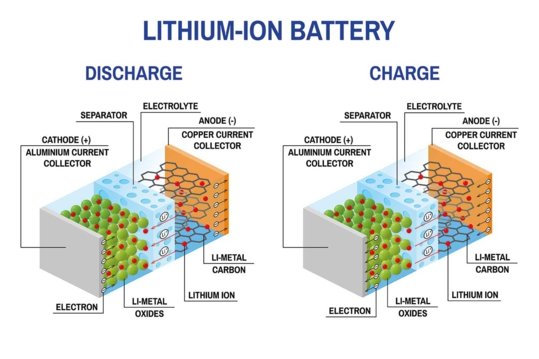Reading time: 6 minutes | Author: Bojan Goluh
Lithium-ion batteries have become the foundation of modern energy storage solutions, powering a range of devices from smartphones to electric vehicles. Essential to their operation is the anode, a fundamental component that supports the exceptional efficiency and versatility of these batteries. This summary delves into the key role of the anode in lithium-ion battery technology, explaining its importance, operation and ongoing progress.
In an era characterized by an insatiable demand for portable, reliable and efficient energy sources, lithium-ion batteries have revolutionized energy storage paradigms. These batteries take advantage of the electrochemical interplay between two key electrodes: the cathode and the anode. Although the role of the cathode in the battery is widely recognized, the contribution of the anode often remains underappreciated.

The anode serves as a gateway for lithium ions during the charge and discharge cycles of a lithium-ion battery. As the battery charges, lithium ions travel from the cathode to the anode and become embedded in its structure. Conversely, during discharge, these lithium ions return to the cathode, releasing energy in the process. This switching of lithium ions between the electrodes stimulates the battery's performance, allowing it to store and release energy as needed.

The anode in lithium-ion battery technology is crucial as it is the driving force behind the basic functionality and performance of these revolutionary energy storage devices. From the fundamental role of graphite to the exploration of advanced anode materials, ongoing research and innovation continues to change the landscape of energy storage. By unraveling the complex interactions of anode materials, scientists and engineers are paving the way for a more sustainable and electrified future that promises higher energy density, longer battery life and transformative applications across a wide range of industries.
For decades, graphite has stood as the archetype of anode materials in lithium-ion batteries. Its layered structure provides an ideal host for lithium ions, allowing them to intercalate between the graphite layers during charging and discharging. This intercalation behavior ensures reversible electrochemical reactions, forming the basis for the stable operation of lithium-ion batteries. While graphite has served as the bedrock of energy storage, the demand for higher energy densities and longer cycle lives has spurred the exploration of alternative anode materials.
Silicon-based anode materials have emerged as a promising avenue for unlocking higher energy storage capacities. Silicon's ability to absorb and release more lithium ions than graphite makes it an attractive candidate. However, the challenge lies in silicon's propensity to undergo significant volume expansion during lithiation, resulting in mechanical stress and capacity degradation over time. Researchers are dedicated to overcoming these hurdles, leveraging techniques such as nanostructuring and hybrid materials to enhance silicon's stability and performance.
Transition metal oxides, including materials like tin dioxide (SnO2) and titanium dioxide (TiO2), offer a diverse array of anode materials with unique properties. These materials exhibit high capacities and varied electrochemical behaviors, presenting opportunities to tailor anode performance to specific applications. However, challenges associated with volume changes, cycling stability, and structural transformations necessitate precise material design and engineering to fully harness their potential.
Advances in anode materials go beyond conventional choices. Researchers are exploring unconventional materials such as carbon nanotubes, metal-organic frameworks (MOFs) and two-dimensional materials, driven by their remarkable properties and potential to revolutionize energy storage. These new materials challenge traditional norms, inspire innovation and push the boundaries of what lithium-ion battery anodes can achieve.As the world continues to embrace electrification and sustainable energy solutions, the development of anode materials for lithium-ion batteries is in the spotlight. From the enduring legacy of graphite to the exciting possibilities offered by silicon, transition metal oxides and more, anode materials are driving the advancement of energy storage technology. Continued research and innovation in anode materials promises a future where batteries are more efficient, longer lasting and capable of driving transformative change in industries.
Lithium-ion batteries have become an integral part of our lives, powering devices ranging from smartphones to renewable energy storage systems. In these batteries, the anode material holds the key to unlocking their potential, which affects factors such as capacity, efficiency and lifetime. This brief delves into the field of anode materials for lithium-ion batteries, exploring their importance, progress and the path they are paving towards a sustainable energy future.
Lithium-ion batteries have cemented their position as the ultimate energy storage solution and ushered in an era of mobility and connectivity. The anode material, which is often overshadowed by the cathode counterpart, plays an indispensable role in these batteries, as it hosts the vital lithium ions that enable the storage and release of energy. Understanding the dynamic interaction of anode materials offers insight into the development of energy storage technology.
The trajectory of anode materials for lithium-ion batteries highlights the evolving landscape of energy storage. From the enduring legacy of graphite to the dynamic potential offered by silicon, transition metal oxides and emerging materials, anode technology is driving energy storage into the future. As global sustainability imperatives gain momentum, the development of anode material fits seamlessly into the quest for cleaner and more efficient energy solutions. The constant search for optimized anode materials paves the way for batteries that not only power our devices, but also strengthen the sustainable energy ecosystem. At Aichelin, we produce furnace systems for the production of battery material. This is how we make our contribution to the further development of the global energy landscape.
Author: Bojan Goluh, [email protected]